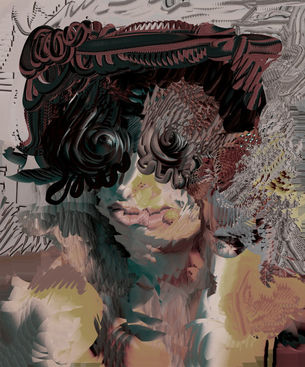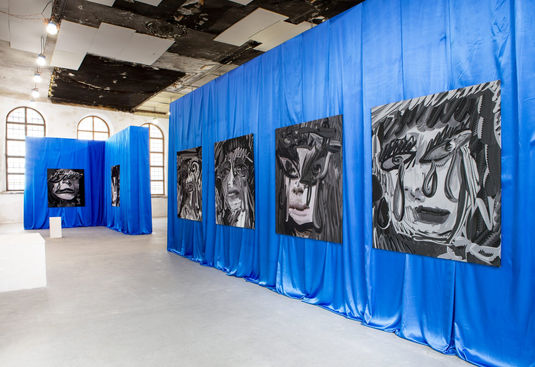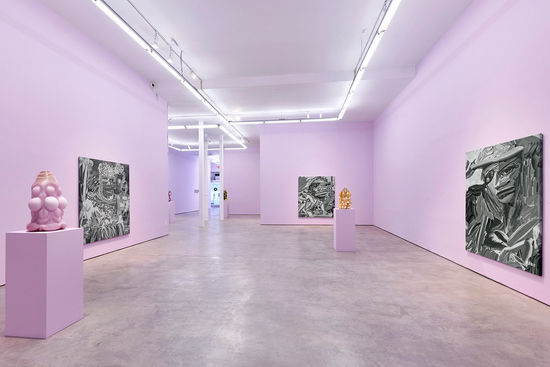For my further artistic practice I would like research the accelerating effect the implementation of digital technology and algorithms has on an individual.
For my further artistic practice I would like research the accelerating effect the implementation of digital technology and algorithms has on an individual.
Artworks and Processes
Artworks and Processes
Artworks and Processes
Artworks and Processes
Here is a heading
Ich bin ein Textabschnit. Klicke hier, um deinen eigenen Text hinzuzufügen und mich zu bearbeiten. Ich bin ein Textabschnitt. Klicke hier, um deinen eigenen Text hinzuzufügen und mich zu bearbeiten.Ich bin ein Textabschnitt. Klicke hier, um deinen eigenen Text hinzuzufügen und mich zu bearbeiten.Ich bin ein Textabschnitt. Ich bin ein Textabschnitt. Klicke hier, um deinen eigenen Text hinzuzufügen und mich zu bearbeiten. Ich bin ein Textabschnitt. Klicke hier, um deinen eigenen Text hinzuzufügen und mich zu bearbeiten.Ich bin ein Textabschnitt. Klicke hier, um deinen eigenen Text hinzuzufügen und mich zu bearbeiten.Ich bin ein Textabschnitt.
Here is a heading
Ich bin ein Textabschnit. Klicke hier, um deinen eigenen Text hinzuzufügen und mich zu bearbeiten. Ich bin ein Textabschnitt. Klicke hier, um deinen eigenen Text hinzuzufügen und mich zu bearbeiten.Ich bin ein Textabschnitt. Klicke hier, um deinen eigenen Text hinzuzufügen und mich zu bearbeiten.Ich bin ein Textabschnitt. Ich bin ein Textabschnitt. Klicke hier, um deinen eigenen Text hinzuzufügen und mich zu bearbeiten. Ich bin ein Textabschnitt. Klicke hier, um deinen eigenen Text hinzuzufügen und mich zu bearbeiten.Ich bin ein Textabschnitt. Klicke hier, um deinen eigenen Text hinzuzufügen und mich zu bearbeiten.Ich bin ein Textabschnitt.
Ry David Bradley

© Bradley, Candle Master, 2021
"The prevailing tendency in my work is to leave the digital as clunky and messy and human as possible, painting freely but somehow refined." – Ry David Bradley
exploring the impact of digital technologies
blurring of boundaries
‘digital painting’ technique
warped/distorted time
oscillation between historical and contemporary technique
capture the highly edited present
NFTs and tapestry
painting inside the image itself
Artist website → http://www.rydavidbradley.com/
Ry David Bradley (b. 1979, Australia) is known as one of the artists at the forefront of new artistic theories and practices exploring the impact of digital technologies on contemporary art and society. His process-based practice investigates the nature of painting in an era where the boundaries between picture, video, and virtual reality are increasingly blurred. (SCG)
While photoshopping and retouching are not new, Bradley’s ‘digital painting’ technique is guided by a painterly approach. These manipulations model not only the physical attributes of paint, but also the physicality of a painting process. The effect is a series of liquid, and uncanny ‘paintings’ where the original photograph is almost entirely obscured. (…) Features distort as if a slow shutter speed captured a portrait during a sudden break in the fabric of reality. This sense of warped time, combined with the inherent nostalgia of subject choice, hints at how imagined distortions take root and then embed additions into lingering memories. (…) Already transformed once, the high-res digital outputs of the original images are then woven as tapestries, creating a kind of skeuomorphic tactile throwback to an earlier kind of image making - an oscillation between historical and contemporary technique. (Jenkins, 2020)
Selection works: Candle Master, 2021 / AMATIA LUCIONI, 2022 / Once Twice - The Hole, New York, 2021
Ry David Bradley
Floorrmagazine (2022)
interview by Charlie Mills
Is there a way to paint that is native to the 21st century, being able to also relate to historic works?
“The site of the 21st century is in many ways on the human face, biometrics is the last form of privacy and security, but also monitoring. You could say the relationship between the smartphone and the face is symbiotic. But people still fall in love, so love and loss are in the face as are many classical concerns. I always ask myself, is there a way to paint that is native to the 21st century, being able to also relate to historic works? In that sense, the face is one place these changes can be reflected, and so by using custom-created software brushes that leave loosely evident their fractured character, this classical trope of portrait painting can also capture the highly edited present. And whatever overlays it will continue to be adorned with as mixed reality becomes more prevalent.” (Bradley in Mills, 2022)
About the availability of his paintings as physical works in the gallery and as non-fungible tokens (NFTs), available for acquisition with Ethereum on SuperRare
“The painting files also were present on the wall in a Decentraland metaverse gallery I designed, at the same time the physical tapestry versions of each work opened at the New York gallery. At 6 pm when the two shows opened, the first NFT was listed on SuperRare also at 6 pm, and minutes later was acquired, sold, and re-aquired at a speed I’d never seen. It felt like the show opened in 3 places at once simultaneously and due to lockdown, I witnessed all of it remotely from the studio in London. Many of the crypto collectors reached out personally on Twitter and the open nature of that transparency was great and new, yet they seemed only interested in the file version. Meanwhile, art collectors in New York pursued the tapestry version, meaning different owners had different states of a work, revealing a preference — one for the blockchain, and one for a woven object. In the end, the NFT state eclipsed the physical work in price, which seemed like a statement by the crypto community, yet in the final sale, the same collector (who was already well known for a large Beeple sale) acquired both states of the work, both NFT and tapestry together. It was all happening in real-time without an exact precedent, so we were trying to learn as we went, right as the clubhouse app was exploding with discussion around this issue.” (Bradley in Mills, 2022)
NFTs and the questions of authenticity
“I think eventually the NFT will become merged with the object so that its registry is how we are able to determine provenance. (…) Regarding 21st Century painting, I still don’t know whether the file state of the painting, which is where I begin, is the authentic version, or the physical manifestation as tapestry is the work. In the present moment, it is a preference that is determined by the owner, but I guess over time some will last more faithfully than others, and that I cannot know. It depends on what angle you approach authenticity from. Is a unique state even possible when there is perpetual entropy? Like all things, authenticity is relative to your position in the lifecycle of things. I sometimes find it hilarious that everything appears quite placid on a regular day on earth yet we are rocketing around the sun at 492 thousand miles per second! Somehow NFT registry will allow our more digital generation to attribute the authors of the creativity we experience online, and it’s nice to know who made something, I think it brings you closer to whatever it may be. Perhaps going forward the anonymous nature of the internet, both beguiling and bewildering, is ultimately knowable. And if something is remade a thousand times, we can see who remade it and celebrate that too.” (Bradley in Mills, 2022)
Your work reveals the intermingling of painting with a generation born net-native, an ongoing process that your work is both symptomatic of and responsive to. For you, what have been the prevailing tendencies of this process in your practice?
“After studying 19th and 20th-century art history it became evident to me that each generation of painters was becoming more and more engaged with the various methods of image creation born of industry. The emergence of animation and cinema had a profound effect on painting at the time, and it seemed as if painting sought to contort itself to reflect the conditions of each time. Painting on a print became something of a merger between images for Rauschenberg and Polke right up to Albert Oehlen in the 1990s computer paintings — but I wanted to paint inside the image itself, on its own terms, something that was impossible in anything but this century. Yet one of my favourite painters ever is Remedios Varo who seemed to be painting dreams, and hopefully, there can be a human timelessness to that pursuit, which also has a digital and fantasy-like nature to it. I guess in some ways painting is always a slippage between what we see and what we feel. The prevailing tendency in my work is to leave the digital as clunky and messy and human as possible, painting freely but somehow refined.” (Bradley in Mills, 2022)

Letmein - w Jon Rafman, Herning Museum of Contemporary Art, Denmark, 2018
References
Jenkins, H (2020) TRANSMISSION. Available at: https://rundog.art/transmission-ry-david-bradley-ss/ (Accessed: 12.11.22)
Mills, C (2022) Ry David Bradley. Available at: https://www.floorrmagazine.com/issue-29/ry-david-bradley (Accessed: 12.11.22)
Sophia Contemporary Gallery (SCG), (n.a.) Ry David Bradley. Available at: https://sophiacontemporary.com/artists/68-ry-david-bradley/biography/ (Accessed: 12.11.22)



